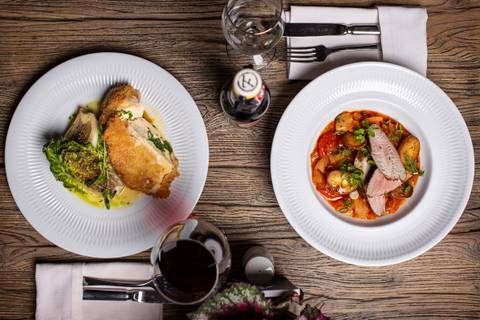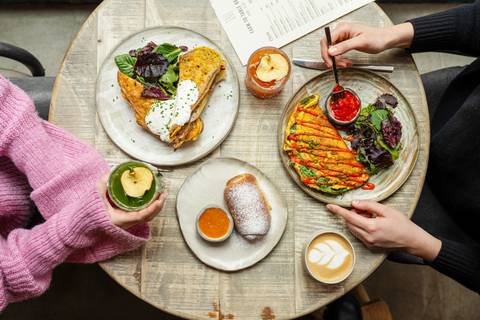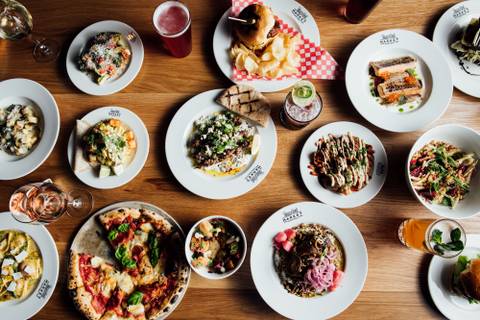The Pest equivalent of Buda’s rustic garden restaurants would be the traditional eateries of Zugló, their home-made dishes, checked tablecloths and shaded courtyards evoking something of the atmosphere you find across the Danube. One classic example is the Aranyhal Vendéglő, with 60 years of hospitality behind it, where classic cuisine, reasonable prices, kind service and modern kitchen technology combine.
Budapest may have many exotic international restaurants but it’s often difficult to find a place that serves revered domestic dishes at fair prices, where they also understand that the sensible modernisation of Hungarian cuisine is not the work of the devil.
The Aranyhal Vendéglő in Zugló has been catering to guests for more than 60 years. It started out as a simple bar, then was a well-known fish restaurant for decades. Current manager Péter Katona took it over eight years ago.
His intention was to make a traditional yet modern, intimate restaurant here, preserving the atmosphere of the original Aranyhal.
His companion in this mission is the excellent Gábor Márfi, who previously worked at Michelin-starred Costes Downtown. Based on their ideas, they have managed to transform this curiosity from the Sputnik era into a petite restaurant more in keeping with contemporary Budapest.
Interestingly, you get a little sense of the menu and the nature of the kitchen as you enter: a beautifully restored wall of bare brick, wooden floorboards, checked tablecloths, cosy lights and tasteful ceramic plates on the wall. It leaves you in no doubt that you’re in Hungary and about to dine, but at the same time, you’re not expecting a hangover from the 1980s.
Retro in, reductions out
“I brought a lot of things from Costes but we didn't want to change to fine dining,” says Gábor. “We wanted the basics to stay, just the technique and the presentation to be more modern. The base for the salmon tartare, for example, came from Costes, but there it’s with a mango reduction, and obviously that's not the case here. But with the right technique, thermomixer or sous-vide bath, traditional Hungarian dishes can get a modern touch in such a way that the end result is absolutely recognisable and authentic, only attuned to the present day.”
The fixed menu is not long – as to be expected for a small restaurant – but there’s also a weekly offer, where seasonality plays a major role. The main menu is updated every few months, but its backbone remains Hungarian, and certain dishes are sacrosanct. The house Aranyhal fish soup (1,590 HUF in a cup, 2,290 HUF in a mini-cauldron), for example, is always available.
Péter reckons that since the Aranyhal (‘Goldfish’) used to be a fish restaurant and the name has survived, they should always have a few piscine dishes, with traditional fish soup a must.
This Baja-style broth is not pasteurised, yet it is dense – due to the high collagen protein content of the fish head cooked in it – with a strong taste, slightly fiery, an excellent serving, with catfish and carp meat, and innards. There is no matchstick pasta, as would be typical for Baja-style, but it comes with crusty yet soft homemade bread.
The fish range is further strengthened by the catfish paprikash with sheeps’ cheese sztrapacska noodles (3,890 HUF), a guests' favourite. In addition, 300 forints from each order is given to those in need within the framework of the Food Bank’s Együnk Egymásért (‘Let’s Eat for Each Other’) initiative.
The other thing they insist on at the Aranyhal is that there should always be something Hungarian on the permanent menu that many people like but no longer make at home. Currently this is tripe stew (2,590 HUF), but there’s also roast veal legs and rooster testicles in the kitchen.
Tripe can be divisive, there are those who love it and many who say it should be banished, but people who like innards but are still tripe virgins can boldly lie back and think of Hungary here: the stewed juice of the beef stomach is thick, finely spicy, the tripe soft, free of any strange aftertaste, and the dumplings provided as a side dish are steaming hot, soft on the inside, crunchy on the outside.
On the plate you can even find confit garlic and pickled chili for strengthening. It’s a matter of taste, of course, and not obligatory. On its own, this is a superbly crafted yet simple classic made from the kind of raw ingredients tripe fans will flock for.
Chalked up on the board are Hortobágy meat pancakes (1,590 HUF), which can also be divisive, a contrary stance over the last three decades blacklisting this dish for many.
Fortunately, there are a few good examples of how it can be done decently, with Aranyhal’s a fair attempt. Although it isn’t made from veal but chicken legs, this should not detract from the enjoyment value, as the filling is succulent, the juice thick without additives as a result of the long boiling, the pancakes dense and soft.
In addition to traditional Hungarian, there are more bistro-type, international dishes not only in the weekly suggestions but also on the main menu: salmon steak with green risotto and crispy parmesan (3,440 HUF), for example. The team aim to open up to a younger crowd, so they try to add more modern, lighter cuisine.
They also create Hungarian-international crossovers, such as the forest-mushroom paprikash potato pancakes (2,290 HUF). The familiar onion, paprika and mushroom stew is made from porcini, wood blewit and chanterelle mushrooms, accompanied by pickled mushrooms, homemade potato pancakes and spicy sour cream.
On the dessert front, the regular feature is homemade apple pie with caramel sauce and ice cream under the name of apple cobbler (1,390 HUF). The inspiration comes from the eponymous dish in one of Jenő Rejtő’s adventure stories set in Marrakech – but this isn’t really a classic British pudding, more a traditional hot apple pie with homemade nut ice cream.
Away from the blackboard and regular selection, they also offer a daily menu at 1,490 forints. Here you can find everything from goulash soup to Milanese pork ribs to wrangler stew, and expect correct, simple, home-made flavours, ideal for a hearty meal if you’re passing.
If you have a little more time, it’s worth investigating the signature dishes as well – just to see how a 60-year-old tavern works when traditional cuisine is combined with contemporary technique. You won’t be disappointed.
Aranyhal Vendéglő
District XIV. Thököly út 121
Open: Mon-Sat 11.30am-10pm, Sun 11.30am-9pm



